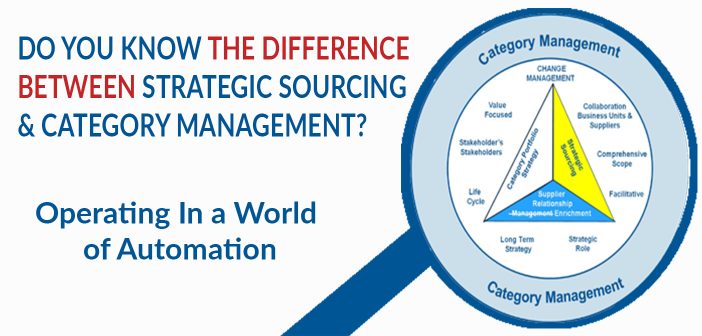If you consider your Procurement organization to be World-Class then you are no doubt implementing, or at a minimum, researching new technology like RPA (Robotic Process Automation) or AI (Artificial Intelligence) or “not so new” technology like Procure-to-Pay or Source-To-Settle applications such as Coupa, Sage, etc. These solutions can go a long way in helping organizations create efficiency through process automation. In theory, this should free up your resources (human) to focus on providing strategic value to your business partners. As you move from Strategic Sourcing to Category Management the need to have a workforce that can provide that strategic value – “thinkers”, as opposed to just “doers” increases exponentially.
In addition to operational efficiency, this new world of automation can and will provide more data at our fingertips than we have ever had before. That’s both good news and bad news. Bad news because more data does not necessarily translate into more or better information. That’s where the “thinker” part comes in. According to a recent article in HBR entitled, “Why AI Will Shift Decision Making from the C-Suite to the Front Line“, “there is no question that big data and AI will bring about important advances in the realm of management, especially as it relates to being able to make better-informed decisions. But certain types of decisions — particularly those related to strategy, innovation and marketing — will likely continue to require a human being who can take a holistic view and make a qualitative judgment based on a personal consideration of the context and facts. In fact, to date, there is no AI technology that is fully able to factor in the emotional, human, and political context needed to automate decisions.”
As we all know, both Strategic Sourcing and Category Management are consulting disciplines that are heavily dependent on data. The ability to
- identity your objective(s) and that of your internal business partners (focusing on their value drivers – what is important to them)
- develop hypotheses (potential solutions to achieve the objectives)
- key questions that will allow you to defend, reject or modify your hypotheses
- determine which data is relevant – the only data required is that which will allow you to answer your key questions
- synthesize the relevant data to create discoveries (which answer the question “so what?”)
- utilize discoveries to draw conclusions and develop recommendations
- utilize your recommendations to persuade your business partners to ACT
will become critical skills as more and more of our activities are automated. While this process may sound complex, it really isn’t BUT it does require a way of “thinking” and reasoning that today cannot be derived through technology. That is the good news! There is a strategic role for us to play as long as we have the skill and competency to play it. The process that I outlined above is the very process that is taught by all the strategy consulting firms to every new consultant (part of their boot camp) before they are sent to work with a client. By the way, it does not matter what functional organization or process they are working with (purchasing, sales, marketing, etc.) the approach to working through strategic problems is the same.
So, if you want your organization to remain relevant and be a valued business partner in the new world of automation, you need to ensure that you have the human resources that are equipped with the skills and competency to play that more strategic role. If you are waiting for someone to tap you on the shoulder to tell you what you need to do, then think again. RPA and AI are HERE and if you don’t start to build your strategic competencies TODAY, you may very well be replaced by robots tomorrow.
Let us know what you think and join in the conversation . . . . . . . .


